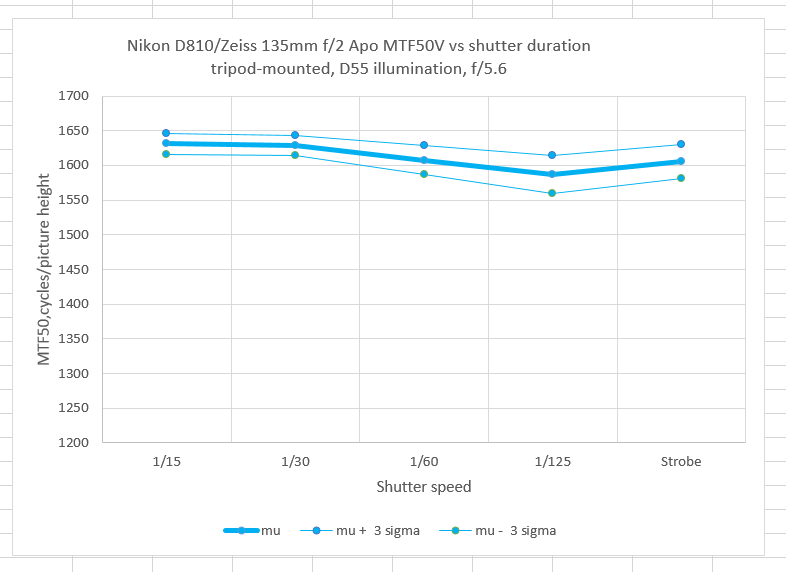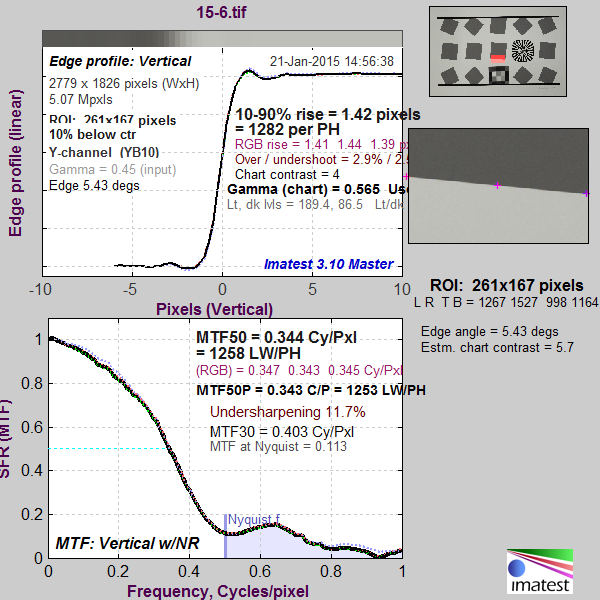A week or so ago, a reader asked if I could try to find out if there’s any vibration difference between a heavy carbon fiber tripod with the skinny legs extended first, or the fat legs extended first. I was doubtful that there would be any difference, and first tried to find out if there was measurable vibration with the skinny-leg-first regime.
I mounted the Zeiss 135mm f/2 Apo-Sonnar to a Nikon D810. I mounted a RRS L-plate, clipped it in landscape orientation into an Arca Swiss C1 head which was attached to a set of RRS TVC-44 legs. There are four leg sections in this tripod; three nested in the one that’s attached to the top plate. I extended the two skinniest legs.
I lit an Imatest SFRPlus target with a Paul Buff Einstein strobe set to 2.5 watt-seconds, which gives a 1/13000 second strobe duration. I set the ISO to 100, the shutter speed to 1/250 second, the shutter mode to 3-second delay and electronic first curtain shutter (EFCS), set the mode to mirror up, focused wide open, and set the aperture to f/5.6. I double tapped the shutter release 16 times. That gave me a set of baseline images with no — or at least minimal — vibration-induced blur.
Then I lit the target with a Fotodiox variable-output 5500K LED light. I set the power to max, and made 16 exposures at 1/125 second. I dialed the light down a stop, and made 16 exposures at 1/69 second. I kept doung that until I got through the 1/15 second sequence. I developed the images in Lightroom 5.7.1 with sharpening and noise reduction turned off, exported them as TIFFs, and measured on-axis MTF50 in both the vertical and horizontal direction.
The results:
The top graph is for horizontal lines, and the second is for vertical ones. The thick lines are the mean values, and the thin ones are three standard deviations higher and lower. You can see that the higher shutter speeds are more problematical than the lower ones, though the differences are small. That’s because the time the second curtain is moving is a larger portion of the time the shutter is open when the shutter speeds are shorter.
You can also see that, since the shutter moves up and down, it affects the horizontal lines a bit more than the vertical ones.
You can also see that the effects are very small. One day, we’ll have global shutters, and the curves will be virtually flat.
But back to the issue at hand. It looks like there’s maybe a statistically significant worsening in the spread in the horizontal sharpness of the 1/125 second exposure over the strobe-lit one, even if the mean is about the same. The mean values for the two slower shutter speeds, both vertically and horizontally, are actually fractionally better than the strobe-lit case.
I dunno. I’m thinking that there will be too much variation introduced by taking the camera off the tripod, adjusting the legs, putting it back on the tripod in as close to the same place as the first time, refocusing, and making a new sequence to answer the original question. And anyway, from the tiny differences between the strobe-lit and continuously lit cases, if there is any difference, it’s unimportant in this case.
By the way, 1700 cycles/picture height is 0.344 cycles per pixel. That’s a very sharp lens!
Note the over and undershoot from the Lr default sharpening, which makes the MTF50 higher than it would be if there were no sharpening.



Rory says
Thanks Jim!
Max says
Jim,
I am 99% sure of this but will have to confirm with my own test but I think that Imatest calculates off of the entire picture width.
Meaning that if you use the full photo of a D810 (7360×4912) and an ROI from the center, you will have a higher Imatest score than if you just use a crop and the same ROI from the same photo.
The screenshot you have above shows a crop of 2779 x 1826 .
Not sure if this makes sense in the whole scope of things but that’s how Imatest does it.
Don’t lose any sleep on this – I’ll test in the AM.
Max
JimK says
Imatest reports MTFs in cycles/pixel as well. It’s up to the user (that would be moi) to convert to cycles per picture height. Imatest has no idea what the actual picture height is.
Max says
I’ll try it both ways but my experience is that the Apo135 will do way higher scores on a D810.
And I’ll be sure to turn off C1 import sharpening this time too. 🙂
JimK says
The list of things that can affect the Imatest MTF50 scores is seemingly infinite, and includes printer, paper, target size, target distance, lighting spectrum, lighting geometry, and more.
Max says
I try to eliminate those variables. Shoot the same target in sunlight. I account for distance by moving tripod to ensure the target fills the entire sensor.
28mm shooting from 2ft away.
135mm from 12 ft away (appx)
JimK says
I’m saying that they are important when comparing your results with other testers.
Max says
Cycles per pixel – full size and crop
https://www.flickr.com/photos/153475477@N06/33051111854/in/album-72157681921278456/
JimK says
Definitely sharpened in post. Plenty of overshoot, which is a dead giveaway. Overshoot is a sufficient, but not a necessary, indicator of sharpening in post. Once an image is sharpened in post, the question is how much sharpening, which makes comparisons of sharpened image MTF50s essentially a crap shoot.
Max says
There was no sharpening in post. Only some exposure adjustment.
Max says
You won’t agree with this but here’s the Otus 28mm into C1 with and without import sharpening.
Not possible but there the scores are.
https://www.flickr.com/photos/153475477@N06/33894921215/in/album-72157681921278456/
JimK says
Both are obviously sharpened. Look at the overshoot.
Max says
They weren’t touched by any sharpening. Only the C1 import presharpening 1 on the 28mm.
Max says
Jim – hang on. You’re right. There was an output sharpening hidden in one of the export tabs. I’m doing it again.
Max says
Redid it w/o output sharpening – still got 1933 for the 135mm and 2473 for the Otus 28mm.
https://www.flickr.com/photos/153475477@N06/33896816645/in/album-72157681921278456/
But the original question was does the crop affect the score ?
Yes! Cycles per pixel of the same non-sharpened 135mm roi was only 701.
JimK says
I don’t know what you’re looking at, Max. The left image on your link shows 0.241 cy/px. The right shows 0.288 cy/px. 701 cy/px is crazy. 701 is 1400 times Nyquist.
Max says
Why are my cy/px numbers lower but my LW/PH higher than yours for the 135 ?
https://www.flickr.com/photos/153475477@N06/33896816645/in/album-72157681921278456/
(the bug comment was a joke)
JimK says
I never reported lw/ph for the D810, or for any other camera that I can remember. The D810 has 4912 pixels from top to bottom. 4912 times 0.241 is 1184 cycles per picture height. Cycles are kind of like line pairs. They are nothing like line widths. It takes two line widths to make one line pair. This is pretty basic stuff, Max. Either I’m misunderstanding your confusion or you should read through the background material on the Imatest web site.
Max says
I give up Jim. I think there’s a bug in the process.
https://www.flickr.com/photos/153475477@N06/33053601424/in/album-72157681921278456/